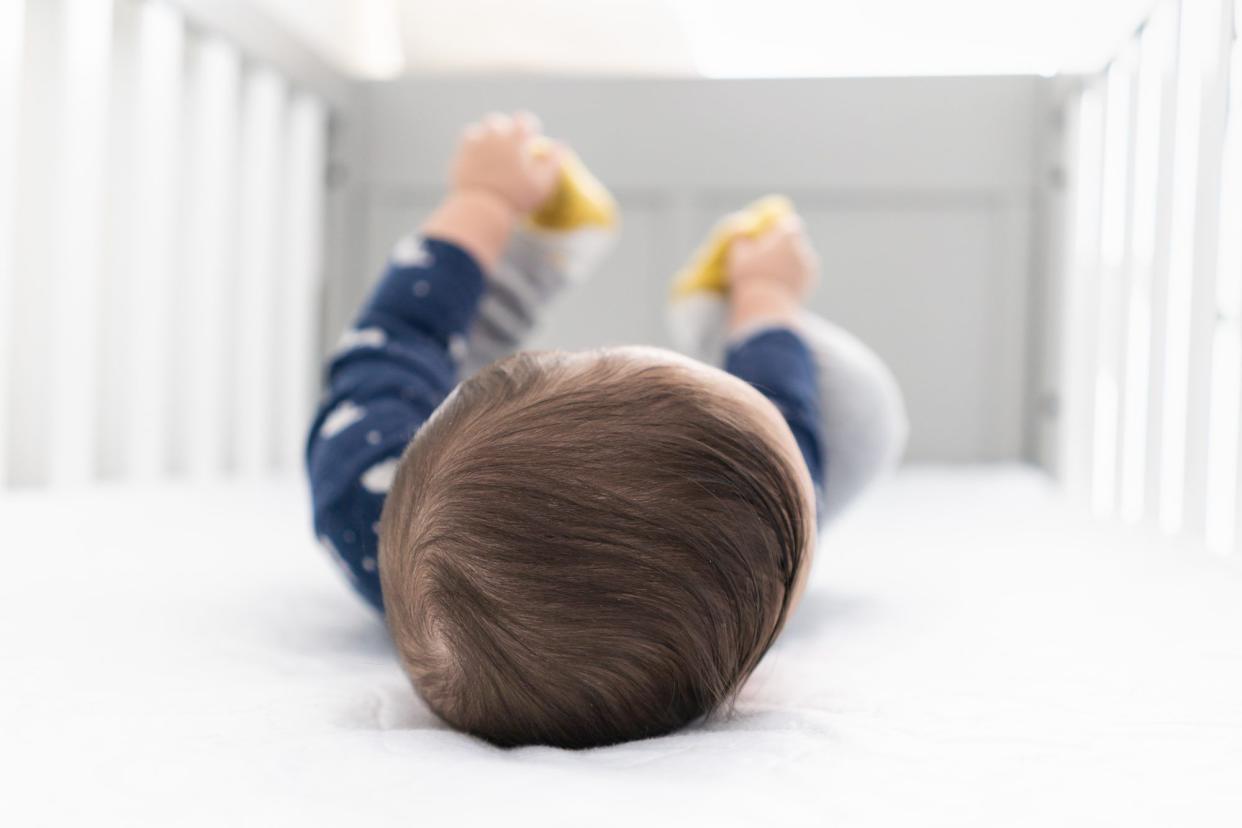Sudden Infant Death Syndrome: Symptoms and Causes Parents Need to Know

If you're a parent, you've likely heard horror stories of families losing babies in their sleep, a cause of death referred to as sudden infant death syndrome (SIDS). The acronym represents every parent's worst nightmare, and has led many families searching for tools to help them prevent it. But new research may help doctors predict who is at higher risk for SIDS in the future. Indeed, according to a May 2022 study, a biochemical marker may actually be the key to unlocking the mysterious cause behind SIDS.
"They [researchers] found the activity of the enzyme butyrylcholinesterase (BChE) was significantly lower in babies who died of SIDS compared to living infants and other non-SIDS infant deaths," explains an article on BioSpace, the digital hub for life science news. "BChE plays a major role in the brain's arousal pathway, explaining why SIDS typically occurs during sleep."
Of course, this news is groundbreaking—but the study did have its limitations and the findings are still only one piece of the puzzle. Parents should still take safe sleeping precautions, like placing babies on their backs when they sleep and keeping toys and blankets out of their cribs. But this research could potentially help to identify which infants are more at risk for SIDS and help to prevent it.
Here's everything you need to know about SIDS, from what it is to what the latest research shows.
TABLE OF CONTENTS
On This Page
What Is SIDS?
How Many Children Die From SIDS Each Year?
What Are the Symptoms of SIDS?
What Causes SIDS?
How Can SIDS Be Prevented?
What Is SIDS?
Sudden infant death syndrome (SIDS) is defined by the American Academy of Pediatrics (AAP) as an infant death which cannot be explained after a thorough case investigation, including a scene investigation, autopsy, and review of clinical history. Due to the sudden and unexplained nature of SIDS, it is a common concern and worry for parents.
How Many Children Die From SIDS Each Year?
According to the Centers for Disease Control and Prevention (CDC), there are about 3,400 sudden unexpected infant deaths in the U.S. each year. Some of those deaths are due to SIDS. Some are due to accidental strangulation and suffocation, as well as abusive trauma.
What Are the Symptoms of SIDS?
"Unfortunately, there are no preceding symptoms of SIDS," says William Mudd, D.O., pediatrician at Cleveland Clinic Children's. However, "the majority of infants will be less than 6 months of age and be found unresponsive, cool, or with dusky gray and blue color changes after they were put to sleep," says Melissa Manrique, M.D., pediatric hospitalist at Lurie Children's at Northwestern Medicine Central DuPage Hospital.
According to one study, sweating may also be a symptom of SIDS in the days and weeks before the infant death.
What Causes SIDS?
While researchers have long believed that brain defects, biological factors, and/or environmental components played a role in sudden infant death syndrome, the cause alluded many. New research released in May 2022, however, could help point to one potential cause of SIDS.
"Babies have a very powerful mechanism to let us know when they are not happy," lead researcher Dr. Carmel Harrington told The Sydney Children's Hospitals Network. "Usually, if a baby is confronted with a life-threatening situation, such as difficulty breathing during sleep because they are on their tummies, they will arouse and cry out. What this research shows is that some babies don't have this same robust arousal response." This deficit reduces an infant's ability to wake, causing vulnerability to SIDS.
How Can SIDS Be Prevented?
While there is not currently a known cause of SIDS, the Centers for Disease Control and Prevention (CDC) recommends that parents and caregivers take the following steps to help reduce their baby's risk of SIDS:
Always place your baby on their back to sleep (even for naps) on a flat surface covered with a fitted sheet
Avoid putting any blankets, pillows, bumpers, or toys in your baby's crib or bassinet
Do not use weighted swaddles, sleepers, or blankets
Keep your baby's crib or bassinet in the same room where you sleep until they are at least 6 months old (ideally until they are 1 year old)
Do not cover your baby's head or allow them to get too hot while sleeping (you can check for sweat or feel their chest)
Never sleep your baby in a swing and/or bouncer
Taking things one step further, on May 16 President Joe Biden signed into law new legislation—the "Safe Sleep for Babies Act of 2021"—that prohibits the manufacture and sale of crib bumpers or inclined sleepers for infants.
And now, based on the new study findings, SIDS could one day be a thing of the past. There may be a way to prevent SIDS—or, to put it another way, there could be a cure.
"Now that we know that BChE is involved we can begin to change the outcome for these babies and make SIDS a thing of the past," added Dr. Harrington. "This finding represents the possibility for the identification of infants at risk for SIDS infants prior to death and opens new avenues for future research into specific interventions."

